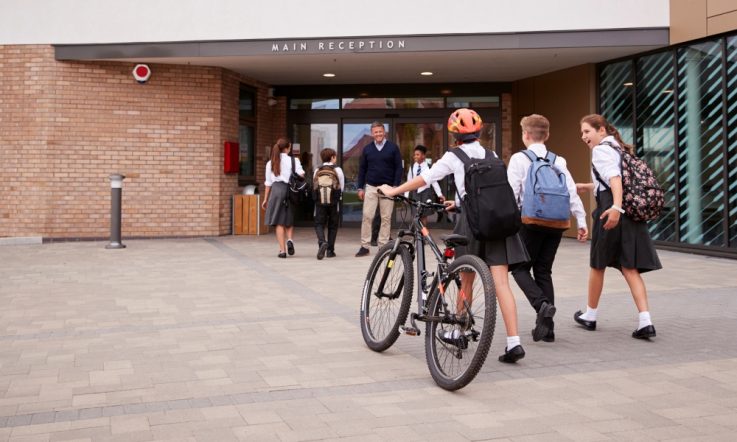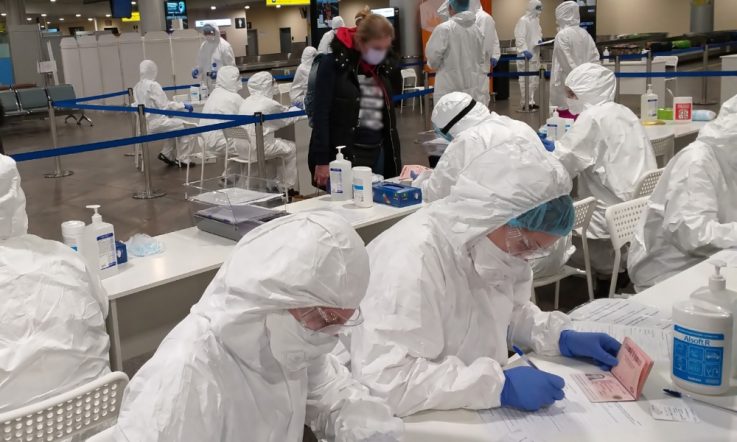International education and Covid-19 – Insights from TALIS
As the world becomes increasingly interconnected, so do the risks we face. The COVID-19 pandemic doesn’t stop at national borders, and it affects people regardless of nationality, level of education, income or gender. But that may not be true for its consequences, which are likely to hit the most vulnerable hardest.
Education is no exception. Those from privileged backgrounds will find their way around closed school doors to alternative learning opportunities, supported by their parents and eager to learn. Those from disadvantaged backgrounds will remain shut out if the school shuts down.
This crisis exposes the many inequities in our education systems – from the broadband and computers needed for online education, through the supportive environments needed to focus on learning, up to our failure to attract talented teachers to the most challenging classrooms.
But as these inequities are amplified in this time of crisis, this moment also holds the possibility that we won’t return to the inequitable status quo when things return to ‘normal’. We have agency, and it is the nature of our collective and systemic responses to the disruptions that will determine how we are affected by them. Our behaviour changes the system, and only mindful behaviour can avoid a breakdown of our education systems.
Mitigating the impact for learners
Where school closures are needed in the short term, we can mitigate their impact for learners, families and educators, particularly for those in the most marginalised groups, who don’t have access to digital learning resources or lack the resilience and engagement to learn on their own. We can collaborate internationally to mutualise open online educational resources and digital learning platforms, and encourage technology companies to join this effort. We can rapidly enhance digital learning opportunities for teachers and encourage teacher collaboration beyond boarders. And we can use the momentum to reshape curricula and learning environments to the needs of the 21st Century. Much of this is already happening.
China was hit first by Covid-19, but reacted fast. Schools were given the highest priority even when financial resources nationwide were tightening, with a ‘green channel’ ensuring quality and efficiency in rapid procurement during the emergency. On 17 February, a national cloud platform was launched, offering digital learning resources to students in schools free of charge across the country. With 7000 servers and 90TB bandwidth, the platform already accommodates 50 million learners simultaneously. And it was not just the government which mobilised resources – a wide range of contributors were stepping forward to provide everything from free wi-fi and devices for students, through innovative instructional systems to social support for teachers and schools.
Importantly, teachers were ready and able to connect with their students remotely, both synchronously for lectures and individual support, as well as asynchronously, with teachers offering online resources for self-directed learning. And those without access to digital resources were not forgotten. In many places, parents could collect free textbooks from schools or ask schools to deliver them to their home.
While schools will be gradually re-opening in China by mid-April, they’re closing around much of the rest of the world. How well are we prepared?
OECD’s TALIS (Teaching and Learning International Survey) offers some insights from the 48 countries that took part, even if the data were collected before the crisis hit, in 2018.
Leveraging technology
While many schools are now equipped with at least a minimum of the technology that is needed for online learning, a quarter of school principals said that shortage or inadequacy of digital technology was hindering learning quite a bit or a lot, a figure that ranged from less than 2 per cent in Singapore, through 30 per cent in France and Italy, to over 80 per cent in Vietnam. Those figures may even understate the problem, as not all principals will be aware of the opportunities that modern technology can provide for instruction.
Add to this that technology is only as good as its use. According to TALIS just 53 per cent of teachers let their students frequently or always use ICT for projects or classwork. However, in Denmark and New Zealand it is 80 per cent or more, and in Finland, Israel or Romania those numbers have more than doubled over the five years leading up to the survey. So things can be different.
According to TALIS, it is not just younger teachers who are using technology more frequently in the classroom, but also teachers for whom technology was included in their formal training. That shows how public policy can make a difference. But only 60 per cent of teachers received professional development in ICT in the year preceding the survey, while 18 per cent reported a high need for development in this area. In this crisis, all teachers need to be involved, and technology allows to close some of the training gaps even during school closures, such as through online training resources – taken up by just 36 per cent of the teachers surveyed by TALIS – virtual professional networks, and online collaboration with younger teachers who are more at ease with technology.
Technology cannot just change methods of teaching and learning, it can also elevate the role of teachers from imparting received knowledge towards working as co-creators of knowledge, as coaches, as mentors and as evaluators. It can enable teachers and students to access specialised materials well beyond textbooks, in multiple formats and in ways that can bridge time and space. Technology can support new ways of teaching that focus on learners as active participants. These are precisely the learning tools that are needed in the 21st Century.
Empowering teachers and enabling innovation
But the heart of learning is not technology, it is pedagogy and ownership. Successful education systems in this moment will do whatever it takes to develop ownership by the teaching profession. When teachers assume ownership, it is difficult to ask more of them than they ask of themselves.
In this crisis, even the best education minister cannot do justice to the needs of millions of students, hundreds of thousands of teachers and tens of thousands of schools. The challenge is to build on the expertise of teachers and school leaders and enlist them in addressing the challenges.
We can look to PISA (Programme for International Student Assessment) top performers Estonia and Finland as examples, whose education systems are entirely built bottom up. Teacher candidates are selected, in part, based on their capacity to convey their belief in the core mission of public education, and they are educated mainly in schools. The preparation they receive is designed to build a sense of individual responsibility for the learning and wellbeing of all the students in their care. The level of trust that the larger community extends to its schools engenders a strong sense of collective responsibility for the success of every student. In turn, the high level of policy coherence, meaning that decisions will be followed through across electoral cycles and political administrations, leads Finnish and Estonian teachers to trust in their education leaders, they count on their capacity to do what they say. Not least, these systems succeeded in aligning resources with needs and reconciling equity with quality, an even more formidable challenge in this crisis, thus making the closest school always the best school.
I meet many people who say we cannot give teachers and education leaders greater autonomy because they lack the capacity and expertise to deliver on it, but those asked only to reheat pre-cooked hamburgers are unlikely to become master chefs. Simply perpetuating our prescriptive approach to teaching will not hold up in this moment of crisis, which demands from teachers not just to replicate their lessons in another medium, but to find entirely new responses to what people learn, how people learn, where people learn and when they learn.
In our industrial school systems, we can easily underestimate the latent potential for innovation. According to TALIS, four out of five teachers say that most teachers in their school strive to develop new ideas for teaching and learning, and still three quarters say that most teachers are open to change. But there is room for greater reliance on this untapped latent potential and more active support from principals: on average only 59 per cent of principals take actions to support co-operation among teachers to develop new teaching practices.
Upholding the social fabric of schools and communities
Perhaps the greatest risk in this crisis is that the social fabric created in and by schools will become fractured. Learning is not a transactional process, where students are passive consumers of content, where schools are service providers and where parents are clients. Learning always happens through interaction and in an environment of wellbeing and self-efficacy for both learners and teachers.
The success of students over the coming weeks and months, particularly those from disadvantaged groups, critically hinges on maintaining a close relationship with their teachers. In this crisis, schools need to provide ways for teachers to remain socially close when they are physically distant. TALIS shows that this comes naturally to teachers: nine out of 10 teachers said they joined the profession to make a difference to the lives of children, and three quarters expressly refer to the opportunity to benefit the socially disadvantaged. The task for school systems is to support teachers in this mission.
As important as it is for teachers to remain connected with their students, the crisis will amplify the need for teachers to remain connected among themselves. TALIS data show even in normal times that proves difficult. On average, less than one in 10 teachers routinely observe their colleagues’ classrooms and give feedback, even when the class was just next door. Just 21 per cent of teachers participate in collaborative professional learning at least once a month, and only 28 per cent of teachers say they teach classes as a team at least once a month. But these are precisely the activities that relate to greater levels of self-efficacy among teachers. Wide differences over time and among countries highlight that this can be different. In Vietnam, 78 per cent of teachers regularly engage in classroom observation, in Shanghai 70 per cent of teachers participate in collaborative professional learning, and in Austria, Italy and Japan team teaching is now common.
Technology can help to accelerate and amplify collaboration among teachers, well beyond the boundaries of their school. Think of the power of ‘collaborative consumption’, where online markets are created in which people share their cars, and even their apartments, with total strangers. Shanghai is already using that to change teaching – many teachers use a digital platform to share their lesson plans. And the more other teachers download, or critique or improve lessons, the greater the reputation of the teacher who has shared them. At the end of the school year, the principal won’t just ask how well the teacher had taught his or her students, but what contribution he or she made to improve the teaching profession and the wider education system. In this way, Shanghai created a giant open-source community of teachers and unlocked teachers’ creativity simply by tapping into the desire of people to contribute, collaborate and be recognised for their contributions. This is how technology can extend the reach of great teaching, recognising that value is less and less created vertically, through command and control, but increasingly horizontally, by whom we connect and work with.
Redefining leadership
What this crisis brings perhaps most to the forefront is the need for effective leadership in education, at every level of the system. Let’s accept that these first weeks will be chaos. There is chaos on a macro, institutional level, and chaos on an individual level for schools and communities.
During great uncertainty, people look for one thing to hang onto as a means to restore order. In education, these will be school leaders who address the immediate needs of students, families, staff and communities, while preparing for ways in which the world of learning and teaching will change. School leaders who are quick to establish their crisis teams, who provide daily social media updates, and who know who owns what and move on it. School leaders who check in with their faculty, staff and administrators, and who understand what additional resources they need and prioritise them.
And school leaders, who reach out to other schools and their communities. Even in peace times that seems not easy. An average of just 38 per cent of school principals in TALIS reported that they engaged in collaboration with principals from other schools over the year preceding the survey. This time of extraordinary challenge is not the time for public versus private, but for public with private.
Not least, this moment requires system leaders who tackle institutional structures that too often are built around the interests and habits of adults rather than learners, leaders who are sincere about social change, imaginative in policy making, and capable of using the trust they earn to deliver effective change. In this moment of crisis, don’t ask yourself how many teachers follow your directions, but how many of them are good at engaging in effective collaboration. These times require leaders, who focus resources, build capacity, and create the right policy climate with accountability measures designed to encourage and facilitate innovation and development, rather than compliance. Leaders, who can show the direction and pave the way towards learning in the 21st Century.
Valuing our teachers
And, perhaps, most importantly, this is the time for leaders who raise the status of those working at the frontline of our societies. In France, where I live, we join our neighbours every evening to applaud the health workers who leave their loved ones in the morning to go to work and save lives. It is time that we show more gratitude also for our teachers who dedicate their lives to helping the next generation realise their dreams and shape our future. When TALIS was carried out in 2018, only 26 per cent of teachers felt valued by society for the work they do. We can do better, and I hope today that number will be higher tonight.



